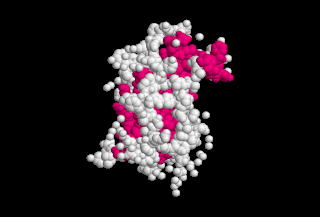
Growth hormone (GH) or somatotropin, also known as human growth hormone in its human form, is a peptide hormone that stimulates growth, cell reproduction, and cell regeneration in humans and other animals. It is thus important in human development. GH also stimulates production of IGF-1 and increases the concentration of glucose and free fatty acids. It is a type of mitogen which is specific only to the receptors on certain types of cells. GH is a 191-amino acid, single-chain polypeptide that is synthesized, stored and secreted by somatotropic cells within the lateral wings of the anterior pituitary gland.
Psychosocial short stature (PSS) is a growth disorder that is observed between the ages of 2 and 15, caused by extreme emotional deprivation or stress.
Somatotropes are cells in the anterior pituitary that produce growth hormone.

Growth hormone deficiency (GHD), or human growth hormone deficiency, is a medical condition resulting from not enough growth hormone (GH). Generally the most noticeable symptom is that an individual attains a short height. Newborns may also present low blood sugar or a small penis size. In adults there may be decreased muscle mass, high cholesterol levels, or poor bone density.
Releasing hormones and inhibiting hormones are hormones whose main purpose is to control the release of other hormones, either by stimulating or inhibiting their release. They are also called liberins and statins (respectively), or releasing factors and inhibiting factors. The principal examples are hypothalamic-pituitary hormones that can be classified from several viewpoints: they are hypothalamic hormones, they are hypophysiotropic hormones, and they are tropic hormones.
Growth hormone–releasing hormone (GHRH), also known as somatocrinin or by several other names in its endogenous forms and as somatorelin (INN) in its pharmaceutical form, is a releasing hormone of growth hormone (GH). It is a 44-amino acid peptide hormone produced in the arcuate nucleus of the hypothalamus.

Laron syndrome (LS), also known as growth hormone insensitivity or growth hormone receptor deficiency (GHRD), is an autosomal recessive disorder characterized by a lack of insulin-like growth factor 1 production in response to growth hormone. It is usually caused by inherited growth hormone receptor (GHR) mutations.

Itabaianinha is a municipality located in the Brazilian state of Sergipe. In 2020, its population was 42,166, and its area is 493 km².
Sermorelin acetate, also known as GHRH (1-29), is a peptide analogue of growth hormone-releasing hormone (GHRH) which is used as a diagnostic agent to assess growth hormone (GH) secretion for the purpose of diagnosing growth hormone deficiency. It is a 29-amino acid polypeptide representing the 1–29 fragment from endogenous human GHRH, thought to be the shortest fully functional fragment of GHRH.

Growth hormone-releasing peptide 6 (GHRP-6), also known as growth hormone-releasing hexapeptide, is one of several synthetic met-enkephalin analogues that include unnatural D-amino acids, were developed for their growth hormone-releasing activity and are called growth hormone secretagogues. They lack opioid activity but are potent stimulators of growth hormone (GH) release. These secretagogues are distinct from growth hormone releasing hormone (GHRH) in that they share no sequence relation and derive their function through activation of a completely different receptor. This receptor was originally called the growth hormone secretagogue receptor (GHSR), but due to subsequent discoveries, the hormone ghrelin is now considered the receptor's natural endogenous ligand, and it has been renamed as the ghrelin receptor. Therefore, these GHSR agonists act as synthetic ghrelin mimetics.

The growth-hormone-releasing hormone receptor (GHRHR) is a G-protein-coupled receptor that binds growth hormone-releasing hormone. The GHRHR activates a Gs protein that causes a cascade of cAMP via adenylate cyclase.
CJC-1295, also known as DAC:GRF, is a synthetic analogue of growth hormone-releasing hormone (GHRH) and a growth hormone secretagogue (GHS) which was developed by ConjuChem Biotechnologies. It is a modified form of GHRH (1-29) with improved pharmacokinetics, especially in regard to half-life.
Hypothalamic disease is a disorder presenting primarily in the hypothalamus, which may be caused by damage resulting from malnutrition, including anorexia and bulimia eating disorders, genetic disorders, radiation, surgery, head trauma, lesion, tumour or other physical injury to the hypothalamus. The hypothalamus is the control center for several endocrine functions. Endocrine systems controlled by the hypothalamus are regulated by antidiuretic hormone (ADH), corticotropin-releasing hormone, gonadotropin-releasing hormone, growth hormone-releasing hormone, oxytocin, all of which are secreted by the hypothalamus. Damage to the hypothalamus may impact any of these hormones and the related endocrine systems. Many of these hypothalamic hormones act on the pituitary gland. Hypothalamic disease therefore affects the functioning of the pituitary and the target organs controlled by the pituitary, including the adrenal glands, ovaries and testes, and the thyroid gland.
Cyril Y. Bowers, M.D., Emeritus Professor of Medicine at Tulane University School of Medicine, attended medical school at the University of Oregon and did an internship at the University of Washington. He then studied biochemistry at Cornell University and attended the Postgraduate School of Medicine at the University of Pennsylvania. From 1961-2004 he was the director of the Section of Endocrinology & Metabolism in the Department of Medicine at Tulane University School of Medicine. Dr. Bowers has served on the editorial board of several endocrine journals, was a member of the National Institute of Diabetes and Digestive and Kidney Diseases Study Section for eight years and has written over 400 articles in peer reviewed journals including chapters in books and over 200 abstracts.
JV-1-36 is a GHRH antagonist that has been shown to inhibit endometriotic cell proliferation and survival, suggesting that GHRH antagonist may represent promising tools for treatment of endometriosis.
Modified GRF (1-29) often abbreviated as mod GRF (1-29), originally known as tetrasubstituted GRF (1-29), is a term used to identify a 29 amino acid peptide analogue of growth-hormone-releasing hormone (GHRH), a releasing hormone of growth hormone (GH). It is a modified version of the shortest fully functional fragment of GHRH, often referred to as growth hormone releasing factor (1-29), and also known by its standardized name, sermorelin.
Growth hormone secretagogues or GH secretagogues (GHSs) are a class of drugs which act as secretagogues of growth hormone (GH). They include agonists of the ghrelin/growth hormone secretagogue receptor (GHSR), such as ghrelin (lenomorelin), pralmorelin (GHRP-2), GHRP-6, examorelin (hexarelin), ipamorelin, and ibutamoren (MK-677), and agonists of the growth hormone-releasing hormone receptor (GHRHR), such as growth hormone-releasing hormone, CJC-1295, sermorelin, and tesamorelin.

Tesamorelin (INN) is a synthetic form of growth-hormone-releasing hormone (GHRH) which is used in the treatment of HIV-associated lipodystrophy, approved initially in 2010. It is produced and developed by Theratechnologies, Inc. of Canada. The drug is a synthetic peptide consisting of all 44 amino acids of human GHRH with the addition of a trans-3-hexenoic acid group.

Examorelin (INN) (developmental code names EP-23905, MF-6003), also known as hexarelin, is a potent, synthetic, peptidic, orally-active, centrally-penetrant, and highly selective agonist of the ghrelin/growth hormone secretagogue receptor (GHSR) and a growth hormone secretagogue which was developed by Mediolanum Farmaceutici. It is a hexapeptide with the amino acid sequence His-D-2-methyl-Trp-Ala-Trp-D-Phe-Lys-NH2 which was derived from GHRP-6. These GH-releasing peptides have no sequence similarity to ghrelin, but mimic ghrelin by acting as agonists at the ghrelin receptor.

The hypothalamic–pituitary–somatotropic axis, or hypothalamic–pituitary–somatic axis, also known as the hypothalamic–pituitary–growth axis, is a hypothalamic–pituitary axis which includes the secretion of growth hormone from the somatotropes of the pituitary gland into the circulation and the subsequent stimulation of insulin-like growth factor 1 production by GH in tissues such as, namely, the liver. Other hypothalamic–pituitary hormones such as growth hormone-releasing hormone, growth hormone-inhibiting hormone, and ghrelin (GHS) are involved in the control of GH secretion from the pituitary gland. The HPS axis is involved in postnatal human growth. Individuals with growth hormone deficiency or Laron syndrome show symptoms like short stature, dwarfism and obesity, but are also protected from some forms of cancer. Conversely, acromegaly and gigantism are conditions of GH and IGF-1 excess usually due to a pituitary tumor, and are characterized by overgrowth and tall stature.






